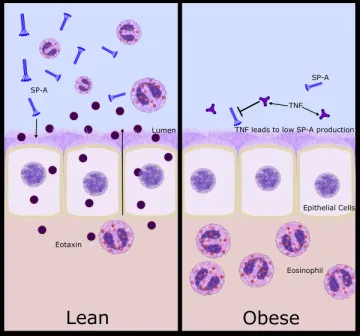Study Finds Molecular Explanation for Poor Symptom Control among Obese Asthmatics
More so than others, obese asthma patients struggle with poor control of their asthma, and symptoms that worsen with time. A team of researchers found one explanation, and has begun developing a therapy to address it.

A large, bouquet-shaped molecule called surfactant protein A, or SP-A, may explain why obese asthma patients have harder-to-treat symptoms than their lean and overweight counterparts, according to a new study led by scientists at the University of Arizona and Duke University. Their results were published in a recent edition of the Journal of Allergy and Clinical Immunology.
The study, titled “Obese Asthmatics Have Decreased Surfactant Protein-A Levels: Mechanisms and Implications,” compared SP-A levels in lean and overweight asthmatics against SP-A levels in obese asthmatics (those with a body mass index, or BMI, over 30). Obese individuals had significantly less of the protein.
To understand why the lack of it is such a problem for those with asthma, one must first understand the function of SP-A. It so happens to be a powerhouse of a protein. It helps curb the lungs’ responses to environmental insults like air pollution. It also regulates the numbers and locations of disease-fighting white blood cells called eosinophils. Without enough SP-A to rein them in, one winds up with too much of a good thing. The eosinophils collect in the lungs and wreak havoc.

Monica Kraft
The team included UA researchers Dave Francisco, Kenneth Addison, Akarsh Manne, William Pederson, Monica Kraft, and Julie Ledford.
Kraft, department chair and professor of medicine, and Ledford, an assistant professor of medicine, are both members of the UA’s BIO5 Institute. They began this research in 2010, when Ledford was a postdoctoral fellow at Duke University and Kraft was chief of pulmonary and critical care medicine.
At that time, SP-A levels in asthma patients were relatively well studied, yet little understood. The literature was shaky. Some research showed that asthma patients have more SP-A than healthy individuals, others found they have less, and some found they had the same amount. Using about 50 samples from the patients of medical doctors including Kraft and Ledford too got mixed results.
“I saw a really wide discrepancy in levels,” said Ledford. “My results matched everything that had been published, so Monica and I looked at patient demographics to see if anything stood out.”
And there in the data, Ledford saw it plain as day: people with especially low levels of SP-A had especially high BMIs. It was the first time anyone had made this connection.

Julie Ledford
This latest study, with data from 55 individuals, shows the same connection Ledford made years ago. The study also provides insights on what is driving that stark difference in SP-A levels between obese individuals and others.
It all starts with something called a “cytokine.” Cytokines are little proteins made by cells in the immune system, giving other cells a signal to take some kind of action. “Do this.” “Do that.” That’s the job of a cytokine. By moving out of a cell, one cytokine called tumor necrosis alpha, or TNF-a, tells other cells to activate the immune system. Obese individuals often have increased amounts of TNF-a.
If you have enough of it, explained Ledford, TNF-a can actually suppress SP-A. And according to this study, in obese asthmatics, it does just that.
“These results are eye-opening in that we’re finding out potentially why obese asthma patients don’t respond as well to treatments as other asthma patients. It could be due to the lack of this important immunoregulatory protein,” said Ledford. “I hope this study will lead to better patient care for this group of people.”
Inconveniently, “SP-A is well known to fight pathogens, so with pretty much any lung infection, someone with less SP-A would be at a higher risk for complications,” said Ledford, adding that across all demographics of asthma patients, SP-A doesn’t work as well as it should to begin with.
Ledford and Kraft are working to translate this information into a new therapy.
“The active piece of surfactant protein A is, we think, 10 to 20 amino acids. We’re putting that piece of it into an inhaler as a delivery,” said Ledford. They are working with Tech Launch Arizona, the UA office that commercializes inventions stemming from research, to develop and license the treatment for those with asthma and other respiratory diseases.
“Fundamentally, we do research to address grand challenges facing our society,” said UA Senior Vice President for Research Kimberly Andrews Espy. “And by taking this groundbreaking discovery from the lab to the marketplace, Drs. Ledford and Kraft will improve the lives of patients with difficult to treat asthma. I am so proud of their work and of the impact it will have for so many. The University of Arizona is an international leader in research in airway diseases and Dr. Ledford and Kraft’s work adds to our record of accomplishment.”

Obese asthmatics have increased TNF-alpha levels, which, in part, leads to decreased SP-A secretion. Subsequently, these individuals have enhanced eosinophilia.
They are now working to further understand what factors, beyond TNF-alpha, might lead to decreased levels of SP-A. The two would also like to study SP-A levels in bariatric patients before and after their weight-loss surgeries.
Said Ledford, “I’m getting to see where and how my work in the lab can affect patient outcomes and, as a scientist, that’s the best reward one can get.”
Extra Info
This research was supported by National Institutes of Health grants HL111151, HL125602, and HL065228.

